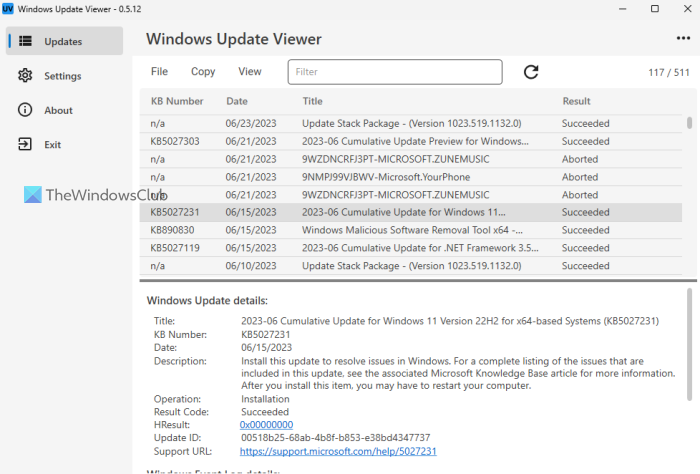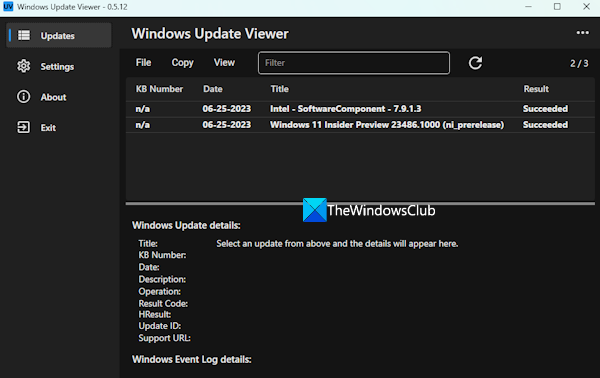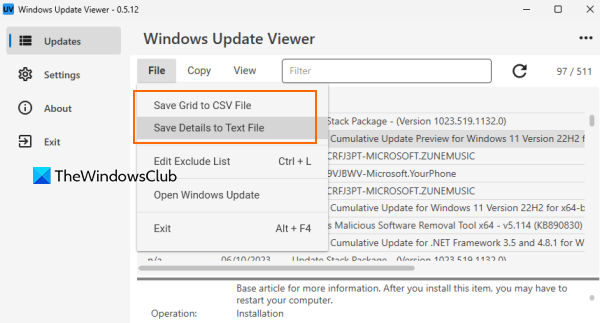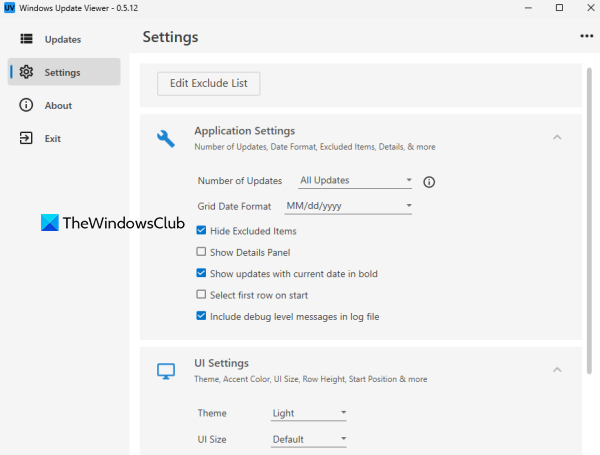Windows Update Viewer is a free tool for Windows 11/10 to view Windows Update history in detail on a user-friendly interface. Though we can easily view a list of installed updates (Feature Updates, Quality Updates, etc.) in Windows 11/10, this tool provides detailed information for each installed update. You don’t have to use a browser to access the support page for a particular update to check the details. In addition, it also lets you export Windows Update history data as a CSV or TXT file for later use whenever needed.

Windows Update Viewer for PC
Using the Windows Update Viewer tool is very easy and apart from viewing Windows Update history in detail and exporting data as a CSV file or a text document, there are some other features provided by this tool such as excluding entries from the list, toggle the details pane, etc.
View Windows Update History in Detail, Export data as CSV or TXT
Download and install process of Windows Update Viewer tool
This free and open-source Windows Update Viewer tool is available with portable and installer versions. You can download it from github.com. If you download its portable version, then extract the downloaded ZIP and execute the WUView.exe application file to open its interface. If you downloaded the setup file, follow the basic installation process. This tool requires .NET Desktop Runtime to install and use successfully. So, you must download and install .NET Desktop Runtime first (if not already).
How to use this Windows Update Viewer tool
Windows Update Viewer tool opens with a black-themed interface that you can change later via Settings. Its interface is self-explanatory. The left section is used to switch between the Updates section, Settings, etc. And, the main part displays a list of Windows Update history (Feature Updates, Driver Updates, Definition Updates, etc.). For each update, you can view the KB number (if present), date, update title, and result (succeeded, failed, aborted, etc.).

When you will select a particular update, you can see detailed information about it. This tool uses Windows event logs and Windows Update API to show details related to installed updates. The detailed information for an update contains two sections:
- Windows Update details: This section provides information like update date, description, result code, HResult, Support URL, KB number, etc.
- Windows Event Log details: Using this section, you can view logs for each event (such as package changed to installed state, if a reboot is necessary before the package can be changed to installed state, etc.) related to the selected Windows update. This section displays information only if the KB number for an update is present.
The interface of this tool also provides a search box or filter that can be used to find a specific update easily as the Windows Update history list could be huge.
In addition to that, you can also switch to a larger view (zoom in), smaller view (zoom out), toggle Details Pane, toggle Excluded List, refresh updates, etc., as per your requirements. For this, you need to use the View menu available on its interface.
Related: How to check Windows Update History using PowerShell or Command Prompt
Export Windows Update History as CSV or TXT file

To export Windows Update history as a CSV file or text file on your Windows 11/10 PC, access the File menu. There, use Save Grid to CSV File option or the Save Details to Text File option to save the data as a CSV file or text document.
The first option only includes a list of Windows Update history including Windows update KB number, title, date, and result. And, the second option creates a single text file containing all the details of each installed update including event log details.
Customize Settings of the Windows Update Viewer tool

You can also access the Settings section of this tool and then customize settings as per your needs. In the Settings section, you can:
- Edit Exclude List: You can add keywords like Defender (one keyword per line) in the available box and the update history will exclude all such entries from showing on its interface
- Select the number of updates (All Updates, 50 Most Recent, etc.) to show, Hide/show Excluded Items, Details Panel, Show updates with the current date in bold, etc.
- Change theme: System theme, Light, Material, Dark, etc.
- Set row height, UI accent color, UI Size, and more.
That’s all!
How do I extract Windows Update history?
The option to extract Windows Update history as a text file, Excel file, etc., is not supported in Windows 11/10. For that, you need to use some third-party tool (like Windows Update Viewer). But there is a dedicated section in Windows 11/10 to view Windows Update history. On a Windows 11 PC, open the Settings app > Windows Update > Update history section, and then you can expand sections such as Quality Updates, Other Updates, etc., to view the installed updates.
If you are using a Windows 10 PC, then open the Settings app > Update & Security > Windows Update > Update history section, and the list of installed updates will be visible.
How do I view Windows Update history in Event Viewer?
If you want to view/read the Windows Update log using the Event Viewer tool in Windows 11/10, open the Event Viewer window first. After that, use the following path:
Applications and Service Logs > Microsoft > Windows > WindowsUpdateClient > Operational
A list of events for WindowsUpdateClient will be in front of you. Select any event and then you can view the information such as log name, event ID, source, task category, etc.
Read next: How to clear Windows Update History in Windows.